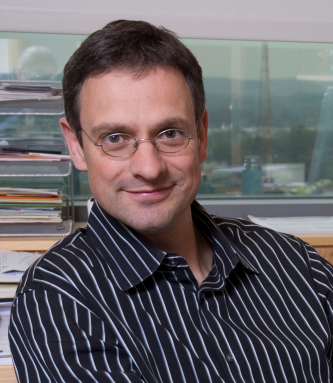 Job Dekker, Phd |
Three leading science publications this month highlight the work of UMass Medical School molecular biologist Job Dekker, PhD, who has developed new technologies for mapping interactions along the genome. Inventor of the 3C, Hi-C and 3C carbon copy (also known as 5C), novel techniques for imaging and mapping sections of the genome, Dr. Dekker, associate professor of biochemistry & molecular pharmacology and molecular medicine, has led the development of a new field of inquiry that some are calling genome cell biology, which seeks to describe how chromosomes are arranged in three-dimensional space and how that topography influences their actions.
Insights produced from Dekker’s techniques help researchers better understand how genes are turned on and how some diseases, such as certain cancers, form. It’s possible that changing the topography of a genome may influence genetic functions leading to disease.
“Knowing which genes cause disease is critical,” said Dekker. “Having a 3D image of a chromosome tells us where to look for areas of the genome that are interacting. It could help identify new genes that are active in diseased cells or regulatory elements that are helping to control those genes.”
The work produced by the Dekker lab over the last several years has been attracting the attention of other molecular biologists and was featured in the following publications this month:
Three leading science publications this month highlight the work of UMass Medical School molecular biologist Job Dekker, PhD, who has developed new technologies for mapping interactions along the genome. Inventor of the 3C, Hi-C and 3C carbon copy (also known as 5C), novel techniques for imaging and mapping sections of the genome, Dr. Dekker, associate professor of biochemistry & molecular pharmacology and molecular medicine, has led the development of a new field of inquiry that some are calling genome cell biology, which seeks to describe how chromosomes are arranged in three-dimensional space and how that topography influences their actions.
Insights produced from Dekker’s techniques help researchers better understand how genes are turned on and how some diseases, such as certain cancers, form. It’s possible that changing the topography of a genome may influence genetic functions leading to disease.
“Knowing which genes cause disease is critical,” said Dekker. “Having a 3D image of a chromosome tells us where to look for areas of the genome that are interacting. It could help identify new genes that are active in diseased cells or regulatory elements that are helping to control those genes.”
The work produced by the Dekker lab over the last several years has been attracting the attention of other molecular biologists and was featured in the following publications this month:
- Scientific American—an article about the three-dimensional architecture of the genome refers to the Hi-C paper authored by Dekker in 2009.
- American Scientist—an article provides an extensive overview of the field of chromosome biology with results from the Dekker lab featured prominently.
- Nature—a special publication celebrating the 10-year anniversary of the sequencing of the human genome includes a feature on the three-dimensional organization of genomes with work by the Dekker lab highlighted frequently.
Related Stories:
Realistic 3D models help scientists understand genome interaction
Van Berkum wins silver medal in invention competition for Hi-C technique